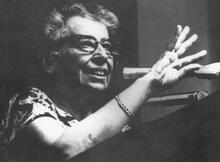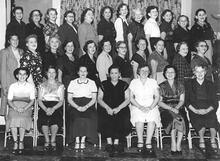Elise Richter
In 1896, the Austrian government permitted women to take matriculation examinations. Elise Richter, 31 years old, was one of the first to take advantage of the new law. She went on to earn a doctorate from the University of Vienna, which appointed her associate professor twenty years later, making her the only woman to hold an academic position at an Austrian university before World War I.
Institution: Gidal-Bildarchiv im Salomon Ludwig Steinheim-Bildarchiv für deutsch-jüdische Geshichte e.g., Duisberg
Elise Richter was born in Vienna and was educated from a young age, but she was determined to pursue a university degree. Before women were permitted into Austrian universities, she audited lectures and took special courses for women. A decree in 1896 allowed Richter to become part of the first group of women to study at the University of Vienna. She received doctoral and post-doctoral degrees and subsequently taught classes on various Romance languages while publishing extensively; however, she only received a paid teaching contract in 1923. Richter continued teaching until she was seventy-three and remained in Austria despite the 1938 Anschluss. She suffered under the restrictions imposed on Jewish Austrians, was deported in 1942, and died in 1943.
One of the first women to earn a doctorate from the University of Vienna, Elise Richter was the only woman to hold an academic appointment at an Austrian university before World War I. As an instructor and later an associate professor of Romance languages at her alma mater until 1938, she made important scholarly contributions to the field of historical and comparative linguistics.
Early Life
The youngest of the three daughters of Maximilian Richter, a physician, and his wife, Emilie, a homemaker, Elise was born in Vienna on March 2, 1865. She and her only surviving sister, Helene, who was four years older, received all of their schooling at home with a Prussian governess, who taught them German, French, and English, as well as history and geography. Like many other girls growing up in cultured, middle-class homes in Vienna, the Richter daughters were exposed to art, music, and theater from a young age, and cultural activities continued to play an important part in their lives. Although of Jewish descent, the family was not affiliated with any religious community. Elise and her sister attended church services occasionally, but never went to synagogue. They were not baptized, however, and were officially registered as konfessionslos, or belonging to no denomination.
As teenagers, Elise and Helene Richter were extremely jealous of boys, who had access to a Gymnasium education, which prepared them for university. Resenting the fact that girls were denied a higher education, they studied foreign languages on their own, Helene specializing in English literature and Elise branching out into Italian, Spanish, and then Latin. In the 1890s, they began auditing university lectures with special permission from professors and enrolled in special classes sponsored by the Association for Advanced Education for Women.
The two sisters maintained very close bonds throughout their lives, living together after the early death of their parents and taking care of one another through many bouts of illness. From the age of twenty, Elise suffered from severe rheumatism and was rarely free of pain. Helene was afflicted with various eye and nervous disorders and frequently experienced depression. Elise compared their relationship to a marriage, which provided mutual support and companionship.
University Education and Career
While the older sister looked after their home, her younger sibling was determined to pursue a university degree and an academic career, despite the formidable odds against her. Helene, an autodidact, eventually received an honorary doctorate from the University of Erlangen on July 22, 1931, on the occasion of her 70th birthday in recognition of her achievements in the field of English literary history. After an Austrian ministerial decree in 1896 granted women permission to take Matura (Austrian matriculation) examinations as externs at a boys’ Gymnasium, Elise Richter, already thirty-one years old, began preparing for her examinations with various tutors, encountering special difficulties with math and sciences, in which she had little background.
The most difficult challenge she faced, however, was not passing the written tests, but reaching the second story of the Akademisches Gymnasium in order to take her orals, since severe rheumatism made it almost impossible for her to climb steps. She received special permission not to have to stand during this lengthy cross-examination. In Richter’s opinion, her Matura in 1897 proved much more of an ordeal than subsequent examinations at university. She was among the handful of women ready to matriculate as soon as the University of Vienna opened its doors to female students.
After studying at the University of Vienna with two leading Romance philologists, Adolf Mussafia and Wilhelm Meyer-Lübke, who became her mentors, she passed her doctoral orals in comparative linguistics with highest distinction (summa cum laude) in 1901, and then her post-doctoral dissertation defense for her university teaching credential (Habilitation) in Romance philology in 1905. It took two more years, however, before she received her official appointment as the very first Privatdozentin, or unsalaried lecturer, in both Austria and Germany. In 1921, she received a promotion to the rank of untenured associate professor, another first for an Austrian woman.
Impact of Female Identity
A pioneering woman in academia, Elise Richter encountered antagonism from some of her male colleagues but eventually gained their respect, along with the admiration of her predominantly male students. She taught a wide range of courses on various Romance languages and published extensively, especially in the field of historical grammar. Only in 1923, however, did she finally receive a paid university teaching contract, which guaranteed her financial independence and enabled her to do less private tutoring and teach fewer adult education courses. She continued to teach phonetics courses at the University of Vienna until she was seventy-three years old, several years past the normal age of retirement.
Elise Richter did not consider herself a feminist. As she explicitly stated in her unpublished memoir, written in 1940, “I avoided the ‘woman’s movement.’ . . . As a feminist I could not make my way in the university; I had not only to direct my entire strength to my work, but also to shun the appearance of feminism” (“Summe des Lebens,” p. 286). Nevertheless, Richter welcomed the right of women to vote and participated actively in Austrian political life during the interwar years as a member of the small liberal Bourgeois-Democratic Workers’ Party. Despite her personal reticence, she helped to establish and then chaired the Federation of University Women of Austria from 1922 to 1930. This organization aimed at assisting women to break into previously inaccessible fields within academia. The International Federation of University Women, of which the Austrian group was a branch, tried to help Richter emigrate to England in 1939, but she declined their offer because she felt so deeply rooted in Vienna and feared being ill in a foreign country.
Nazi Austria and Legacy
Richter tried unsuccessfully to avoid acknowledging her Jewishness and antisemitism. Whereas a former student recalled his class taking a final French phonetics examination in Professor Richter’s apartment in the early thirties, at a time when the university was closed temporarily due to antisemitic violence, she does not mention such events in her memoirs prior to the March 1938 Anschluss. Thereafter, however, she suffered many humiliations due to her Jewish descent. Not only was she dismissed from her teaching position, but she was also banned from using the university library and prevented from visiting museums and theaters. Her property, including her library, was confiscated and, although she continued her scholarly work until 1941, she could no longer publish in Germany.
In October 1942, Elise and Helene Richter were deported to Theresienstadt on the last large transport from Vienna. Both sisters became victims of the Holocaust; Helene Richter died in November 1942 at the age of eighty-one and Elise Richter died on June 21, 1943, of unknown causes, at the age of seventy-eight.
Elise Richter overcame many obstacles to become an important figure in Romance philology in the early twentieth century. After her long and distinguished career as a scholar and a teacher, her students and disciples did not forget her, but continued to publish her work posthumously. The Austrian government erected a plaque in her memory as the first woman professor at the University of Vienna.
Selected Works by Elise Richter
“Erziehung und Entwicklung.” In Führende Frauen Europas, edited by Elga Kern, Vol. 1, 70–93. Munich: 1928.
“Summe des Lebens: Lebensfreuden/Lebensleid.” Vienna, 1940. Landes- und Stadtsarchiv, Vienna, Manuscript Collection, Nachlass Elise und Helene Richter, MA9, 336/47, III, 37/3, Box 3.
“Der innere Zusammenhang in der Entwicklung der romanischen Sprachen.” Prinzipienfragen der romanischen Sprachwissenschaft, Zeitschrift für Romanische Philologie. 27 (1911): 57–143.
“Beiträge zur Geschichte der Romanismen. 1: Chronologische Phonetik des Französichen bis zum Ende des 8. Jahrhunderts.” Zeitschrift für Romanische Philologie. 82 (1934).
Kleinere Schriften zur allgemeinen und romanischen Sprachwissenschaft, edited by Yakov Malkiel. Innsbruck: 1977.
Benjamin M. Woodbridge, Jr. “A Bibliography of the Writings of Elise Richter.” Romance Philology 26 (1972): 342–360.
Andraschko, Elisabeth “Elise Richter – eine Skizze ihres Lebens.” In “Durch Erkenntnis zu Freiheit und Glück ...”: Frauen an der Universität Wien (ab 1897), edited by Waltraud Heindl and Marina Tichy, 221–231. Vienna: 1990.
Christmann, Hans Helmut. Frau und “Jüdin” an der Universität: Die Romanistin Elise Richter (Wien 1865–Theresienstadt 1943). Wiesbaden: 1980.
Dick, Jutta and Marina Sassenberg. Jüdische Frauen im 19. und 20. Jahrhundert. Reinbek bei Hamburg, 1993: 315–317.
Forkl, Martha and Bertholds Plechl. “Elise Richter und der Verband der Akademikerinnen Österreichs.” In Frauenstudium und Akademische Frauenarbeit in Österreich, edited by Martha Forkl and Elisabeth Koffmahn, 108–112. Vienna: 1968.
Freidenreich, Harriet Pass. Female, Jewish, and Educated: The Lives of Central European University Women. Bloomington: 2002.
Hoffrash, Christiane. Bücherspuren: Das Schicksal von Elise und Helene Richter und ihrer Bibliothek im Dritten Reich. Böhlau Verlag, 2009.
Raggam-Blesch, Michaela. “A Pioneer in Academia: Elise Richter.” In Jewish Intellectual Women in Central Europe 1860-2000 – Twelve Biographical Essays, edited by Judith Szapor, Andrea Peto, Maura Hametz, and Marina Calloni, 93-128. New York, NY: Queenston, ON: The Edwin Mellen press, 2012.
Spitzer, Leo and Helene Adolf. “In Memoriam Elise Richter.” Romance Philology. 1 (1947–48): 329–341.
Thieberger, Richard. “Assimilated Jewish Youth and Viennese Cultural Life around 1930.” In Jews, Antisemitism and Culture in Vienna, edited by Ivan Oxaal, et al., 180–183. London: 1987.
Warner, Natasha. "A fascinating personage in the history of phonetics: The phonetics and the politics of Elise Richter." The Journal of the Acoustical Society of America 123, no.5 (2008): 3324-3324.
Wille, Christa. “Frohmachende Wissenschaft?” Initiative Wissenschaft. 1 (1990): 24–36 and 2 (1991): 20–22.
Woodbridge, Benjamin M. and Yakov Malkiel. “Elise Richter: Two Retrospective Essays.” Ibid. 26 (1972–73): 335–331.














